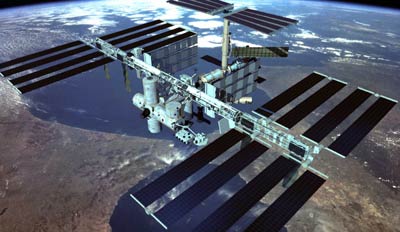Finishing the space station: an essential part of the Visionby Taylor Dinerman
|
| Satisfactorily finishing the ISS was one of the original primary goals of the Vision for Space Exploration. There are several reasons for this, but they have never been properly articulated by the administration or NASA. |
It will take at least seven shuttle missions to complete the truss, solar array, and heat radiator assembly. This means that the heads of agency decision to launch ESA’s Columbus and Japan’s Kibo modules before the main power and temperature control system is fully installed was not made on the basis of logic. Instead, it looks as if two factors are involved: first, the Europeans and Japanese are afraid that unless they get their station elements up there as fast as possible they will never arrive. Second, once their modules are attached they automatically receive certain privileges, including a bigger say in ISS operations. Mike Griffin seems to have decided to humor them.
Satisfactorily finishing the ISS was one of the original primary goals of the Vision for Space Exploration. There are several reasons for this, but they have never been properly articulated by the administration or NASA. The first and most obvious reason to complete the station is that America should finish what it starts, while a related reason is that if at all possible it’s a good idea for a nation to keep its international commitments. Building the ISS with the Russians may not have kept many of their scientists and engineers from working on Iran’s missile and nuclear programs, but is has created a set of human relations that are valuable for their own sakes.
Orbiting below the Earth’s radiation belts, the ISS is an imperfect place to study the effects of long-duration spaceflight on the human body. Nevertheless, it is the only place NASA now has where such studies can be done. Without the accumulated experience gathered on the ISS, long-term trips to the Moon and eventually Mars will inevitably be more difficult and dangerous. The ISS is also the place where NASA and its partners are testing new ideas for pressure suits, life support systems, and tools. Knowing how large numbers of smaller items and systems work and interface in space cannot be simulated on Earth.
For the next fifteen years or so the ISS will be the only permanent human presence off Earth. The idea that after 2015 the US will wholly abandon it is just not in the cards. What is far more likely is that the US will scale back its role on the station and allow the Russians and the others to assume an ever greater, controlling role. The Europeans and Japanese will then be able to perform all the scientific research they had hoped to do at an earlier stage of the program. The US may decide that it wants to use the ISS for similar research, but that is not a decision it has to make any time soon.
One of the so far unspoken roles of the ISS is that it, along with the shuttle, serve as “anti-models” for US future plans. Instead of relying on foreign partners, NASA is choosing to build the main elements of its future space exploration systems—the Crew Exploration Vehicle, Crew Launch Vehicle, and Heavy-Lift Launch Vehicle—itself. As a backup, NASA is going to support the private sector via the Commercial Orbital Transportation System (COTS). The plan includes the possibility that someday American astronauts will fly to the ISS, or even to the Moon, as passengers on a commercial spacecraft.
| One of the so far unspoken roles of the ISS is that it, along with the shuttle, serve as “anti-models” for US future plans. Instead of relying on foreign partners, NASA is choosing to build the main elements of its future space exploration systems itself. |
This is no longer as absurd as it once sounded. After all, American military personnel can deploy overseas either on Air Force planes or regular passenger aircraft: it depends on the mission. The COTS program has at least the promise of providing alternative manned space access somewhat along the lines of the EELV program, which was designed to ensure that if one rocket fails, the US military will still have a way to get its payloads into orbit.
Once the US has begun to build an outpost on the Moon, maybe around 2025, it is only prudent to have at least two ways of transporting people there and back. While the CEV and a lunar lander will be the main vehicles, having a proven commercial service available will not only provide a greater level of safety, but it will allow of the early creation of private sector lunar operations.
Unlike the ISS, which is a fine example of intergovernmental relations, COTS is leading towards manned space operations with room for both governments and capitalists. NASA has had a hard time finding ways to effectively integrate non-governmental actors into its operations. If it can stick to its current concept and if the American entrepreneurial community responds, then just maybe the US will no longer have to take a back seat to Russia when it comes to the commercial exploitation of human spaceflight operations.
